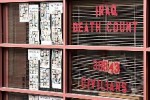Death on display

If you have been inside the Communication and Information Sciences building at any time during the last year, chances are you noticed some large numbers displayed on the outside window of one of the offices on the third floor. If you took a closer look, you would have seen large block letters above those numbers displaying the words, “Iraq death count.”
The person behind this display is Wendy King, a communications graduate student studying visual culture and travel.
King got the idea to display the civilian death count – a number found on iraqbodycount.net – after watching a film on a project called Stone Walk, which memorialized “unkown civilians killed in war” along with military casualties.
King was inspired by the effort and decided to create a sort of memorial of her own when she became a graduate student and moved into her new office.
“When I moved into this office the war was going on and I felt this kind of disconnect with being concerned about myself and school and here was this world event with people losing their lives,” said King.
King felt that being a graduate student was a very self-centered thing to do and she had a problem with that feeling. She thought that doing something political would help.
Initially the idea was to let students know that there were bigger things going on in the world around them. King felt that there was a lack of reporting regarding civilian deaths.
“The semester started and we’re all running around worrying about things and it’s not that they are not important but this is what’s going on in the broader world,” said King.
When King began the project she and her officemate turned the changing of the numbers into a sort of ritual.
“We would change the number religiously once a week when we first started doing it,” said King. “It was sort of a performance, we had an exact time once a week where we would change the numbers so that if people wanted to see the change they could.”
King soon found that numbers were too abstract and didn’t quite have the visual impact that she was hoping for. She decided to add pictures of the U.S. and Coalition casualties to her display. She got the pictures from CNN.com.
“It was so abstract, the numbers would change but they were still numbers so we decided to add the faces,” said King. “I think that makes it a little more tangible rather than just numbers.”
So far the response to King’s display has been limited.
“The second day that we put this up the professor in the office across from us put up a sign that said, ‘That’s the cost of freedom,’ – it was this sort of dialogue,” said King.
The professor eventually took the sign down and King never found out who he or she was. Aside from the anonymous sign there has been no response to King’s display.
“I don’t think she should be able to put that up there,” said Amanda Ojeda a senior majoring in telecommunications. “I don’t think politics should mix with school even though I am against the war.”
Jeanine Minge, a fellow graduate student and office neighbor to King, feels that the student-teacher relationship is not conducive to political debate.
“I think there is a power relationship there that makes it difficult to talk,” said Minge. “I think Wendy’s (King) piece sparks dialogue which is activism in itself. I know that there is a big response to her piece. When people walk in there is a visceral response, some people get very angry.”
“I’m making a statement, I am against the war,” said King. “It’s not something that’s just in the news. There are lives being lost everyday while we are here, over this war that was started under false pretenses.”
Ideally King would like to see students be more politically active. She feels that if people educate themselves they can take that attitude to the voting booth and put pressure on the White House.
“I feel like there is a lack of activity among students,” said King. “Students today hold multiple jobs. Everybody is so busy trying to make a living.”
King’s sentiments regarding student attitude toward the current political environment seem to be reflected locally in the lack of response she has gotten from her own attempt at activism.
Minge suggests that activism does not have to be as complicated as people are led to believe.
“We are too attached to the idea that protest needs to be with big picket signs or a rally when protest can happen in your everyday life,” said Minge.
Minge agrees that apathy is present on campus but also believes that it extends past the student body and into the populous as a whole.
“We are content to stay where we are. We work to make the money to be able to go home and rest with our families and get up the next day and to the same thing,” said Minge.
King echoes Minge’s thoughts in her own ideas regarding the apathy of society in general.
“It’s the silence that kind of terrifies me,” said King. “There is a level of denial, it’s not that they don’t care, they just get caught up in this rat race.”
King believes that her window will eventually be completely covered by the faces of the dead. Her colleagues in the adjacent offices have agreed to allow her to continue the display on their windows. Minge said that she would absolutely let King continue her display on her own office window.





